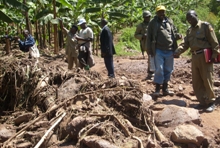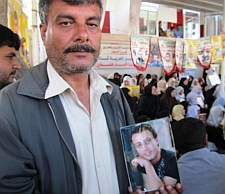Susan Anyangu-Amu
NAIROBI, Feb 2 2010 (IPS) – The threat by influential Christian leaders to mobilise a vote against Kenya s draft constitution if it does not explicitly prevent any expansion of abortion rights appears to have succeeded.

Thousands of young women risk their health procuring abortions each year: will a new constitution entrench restrictive laws on termination? Credit: Ann Weru/IRIN
The draft assembled by a Committee of Experts for consideration by the Parliamentary Select Committee (PSC) contained no specific reference to abortion, but the National Council of Churches (NCCK) and the Catholic Church were up in arms about a phrase stating that everyone has a right to life while failing to define where life begins and ends.
Canon Peter Karanja of the NCCK told IPS, Life is sacrosanct. The definition of life must be stipulated in the supreme law of the land, the Constitution. Life must be defined as starting at conception and ending at natural death.
The parliamentary committee has completed deliberations on the draft, and decided to define life as beginning at conception.
Phrases guaranteeing everyone the right to health care (including reproductive health care) and stating that no one may be refused emergency medical treatment have been deleted; added is a phrase ruling out abortion unless in the opinion of a registered medical practitioner the life of the mother is in danger .
The changes have raised an uproar, with professional associations of medical practitioners saying it will have negative effects on Kenya s attempt to reduce maternal deaths.
Related IPS Articles
As health care providers, we are familiar with both the human impact of unsafe abortion and the public health burden it represents. Including prohibition against abortion in the constitution and defining life as beginning at conception will fail to prevent incidences of abortion, says Dr Otieno Nyunya, chairman of the reproductive health committee of the Kenya Medical Association.
Grace Maingi-Kimani, the acting executive director of Federation of Women Lawyers Kenya (FIDA), says the move by the PSC is disheartening and will serve to limit access to choice for women and young girls who are raped and end up pregnant.
The PSC was not thinking about the hundreds of women who were raped during the post-election violence and were forced to have children sired by men who violated them and possibly killed their husbands. The PSC was not thinking of young girls who are abused by their teachers and forced to cut short their education due to unwanted pregnancies, Kimani says.
It is the poor women and teenage girls who die at the hands of quacks, says Professor Joseph Karanja, an associate professor of obstetrics and gynaecology at the University of Nairobi.
He says wealthy, well-educated women are able to find safe ways to terminate pregnancies; ignoring international commitments Kenya has made guaranteeing the right to health, he charges, the PSC, has created a platform that puts the most vulnerable at still greater risk.
On its part, the Church is happy with the prohibition of abortion and definition of life as beginning at conception, and has again warned it will reject anything less.
We should not victimise the innocent unborn children, who do not have a say in this matter. Even in the case of rape and incest, the life in the womb of the woman is innocent, says Father Paulino Wondo of the Holy Trinity Catholic Mission in the Nairobi slum of Kariobangi.
Members of the Kenya Medical Association, FIDA, Kenya Obstetrical and Gynaecological Society, Family Health Options Kenya and the National Nurses Association of Kenya, have written a protest note to the PSC, the Committee of Experts and Parliament, calling for the controversial phrases to be reviewed.
Currently, abortion is permitted in Kenya only to save the life of the mother. Despite this, every year large numbers of women seek assistance to terminate pregnancies wherever they can find it.
Dr Joachim Osur, an advisor with reproductive health rights organisation IPAS a member of the RHRA argues that opponents of expanded abortion rights in Kenya have their heads buried in the sand.
Despite termination of pregnancy being restricted in Kenya, induced abortions remain common. In Kenya it is estimated that 300,000 spontaneous and induced abortions occur annually, about 29 abortions for every 100 live births, says Osur.
Unsafe abortions contribute a significant margin to the maternal deaths in this country at 30 percent. It is estimated that 2,000 women die annually from unsafe abortions.
Dr Otieno Nyunya, chairman reproductive health committee of the Kenya Medical Association says research done by his association alongside IPAS and FIDA in 2004 found 316,560 spontaneous and induced abortions occurred that year.
Nearly 21,000 women are admitted each year to Kenya s public hospitals for treatment of complications from incomplete abortions, either spontaneous or induced.
The study further shows that 800 unsafe abortions are performed every day and 2,600 women die from unsafe abortions in Kenya each year, representing 30 to 40 percent of Kenya s total maternal deaths, according to Kenya Obstetric and Gynaecological Society and Kenya Medical Association.
Nyunya says that 60 percent of the beds in the gynaecological ward at Kenyatta National Hospital, the largest referral hospital in East and Central Africa, are occupied by patients suffering from abortion complications.
He says a conservative estimate of the cost to the state for the management of these cases is approximately four million dollars a year.
The cost to women s lives is much higher.




